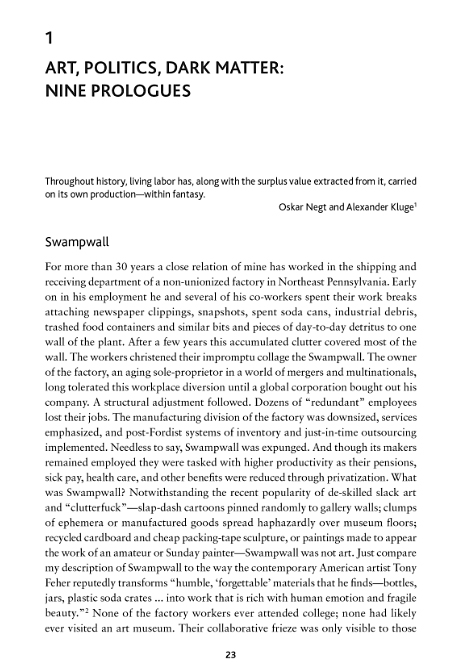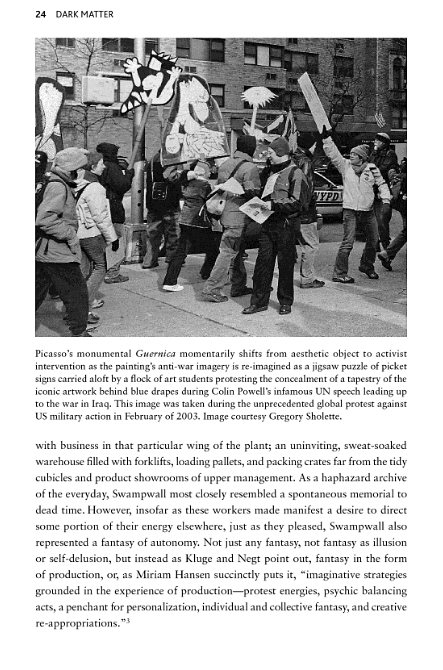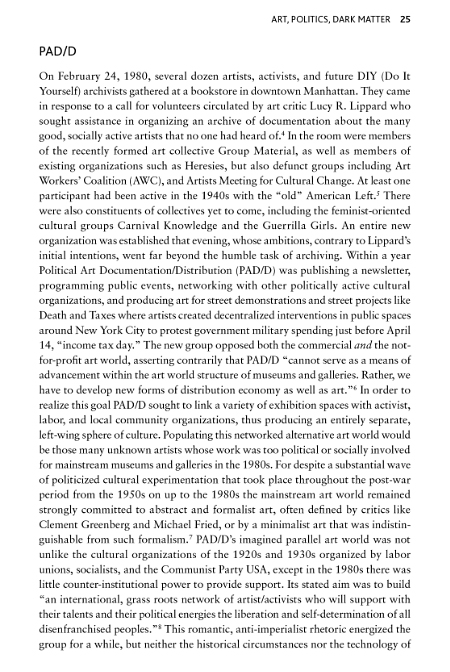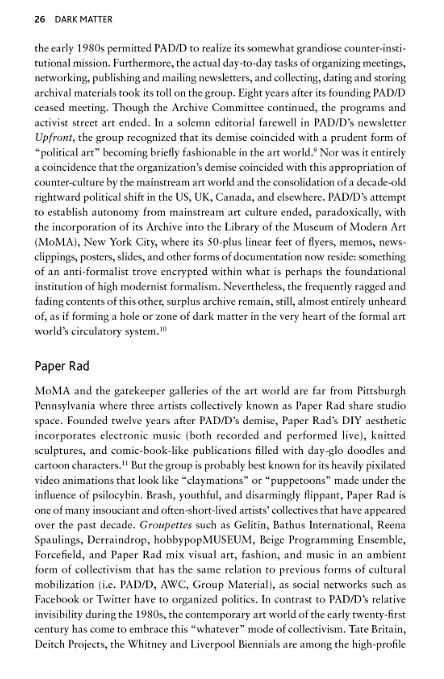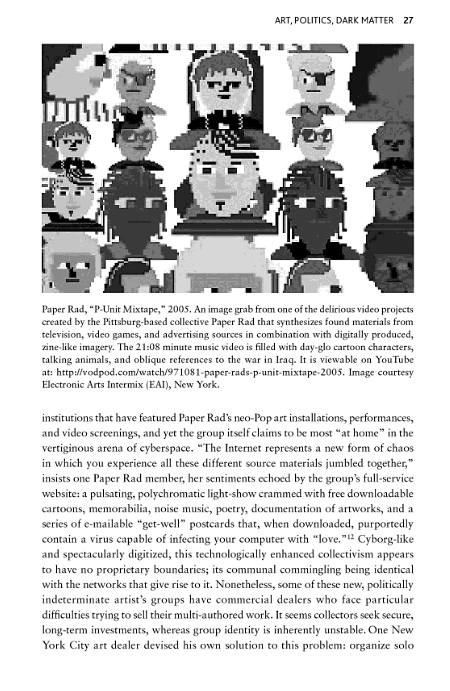table of contents reviews excerpts book discount where to buy lectures
INTRODUCTION: THE MISSING MASS
Astrophysicists describe dark matter (and dark energy) as forming an invisible mass predicted by the big bang theory, yet so far only perceived indirectly by observing the motions of visible, astronomical objects such as stars and galaxies. Despite its invisibility and unknown constitution, most of the universe, perhaps as much as 96 percent of it consists of dark matter, a phenomenon sometimes called the “missing mass problem.” The gravitational presence of this unseen force presumably keeps the universe from flying apart. This book borrows the metaphor of an unknown but ubiquitous stellar mass and applies it to the world of art and culture. Like its astronomical cousin, creative dark matter also makes up the bulk of the artistic activity produced in our post-industrial society. However, this type of dark matter is invisible primarily to those who lay claim to the management and interpretation of culture – the critics, art historians, collectors, dealers, museums, curators, and arts administrators. It includes makeshift, amateur, informal, unofficial, autonomous, activist, non-institutional, self-organized practices – all work made and circulated in the shadows of the formal art world, some of which might be said to emulate cultural dark matter by rejecting art world demands of visibility, and much of which has no choice but to be invisible. While astrophysicists are eager to know what dark matter is, the denizens of the art world largely ignore the unseen accretion of creativity they nevertheless remain dependent upon.
Consider the destabilizing impact on high art were some of these hidden producers to cease or pause their activity. What would happen for example if the hobbyists and amateurs who purportedly make up a billion-dollar national industry in the US simply stopped purchasing art supplies or no longer took classes with “professional” artists, or ceased going to museums to see what bona fide artists do?2 And why consider only the tactical withdrawal of amateur participation, which is by definition marginal? What about the dark matter at the heart of the art world itself? Consider the structural invisibility of most professionally trained artists whose very underdevelopment is essential to normal artworld functions. Without this obscure mass of “failed” artists the small cadre of successful artists would find it difficult, if not impossible, to sustain the global art world as it appears today. Without this invisible mass, the ranks of middle and lower level arts administrators would be depleted, there would be no one left to fabricate the work of art stars or to manage their studios and careers. And who would educate the next generation of artists, disciplining their growing numbers into a system that mechanically reproduces prolific failure? Furthermore, by purchasing journals and books, visiting museums and belonging to professional organizations, these underdeveloped “invisibles” represent an essential pillar of the elite art world whose pyramidal structure looms over them eternally out of reach.
And yet there is no material difference between an earnest amateur on one hand, and a professional artist made invisible by her “failure” within the art market on the other; except perhaps that against all the odds she still hopes to be discovered? How would the art world manage its system of aesthetic valorization if the seemingly superfluous majority—those excluded as non-professionals as much as those destined to “fail”—simply gave up on its system of legitimation? Or if they found an alternative to it by creating a Peer-to-Peer (P2P) network of support and direct sales bypassing art dealers, critics, galleries, and curators? Indeed, to some degree this has already begun to take shape via media applications of Web 2.0. What has not happened is any move towards re-distributing the cultural capital bottled up within the holding company known as high art. All of these forms of dark matter play an essential role in the symbolic economy of art. Collectively, the amateur and the failed artist represent a vast flat field upon which a privileged few stand out in relief. The aim of this book is to raise an inevitable question: what if we turned this figure and ground relation inside out by imagining an art world unable to exclude the practices and practitioners it secretly depends upon? What then would become of its value structure and distribution of power?
The answer is not to imagine the emergence of a more comprehensive social art history in which the usual art subjects are better contextualized. Nor is it to take part in some rarified tour of this dark-matter world in which the mysterious missing cultural mass is acknowledged, ruminated over, and then re-shelved or archived as a collection of oddities. Instead, when the excluded are made visible, when they demand visibility, it is always ultimately a matter of politics and a rethinking of history. This is often the case with artists’ collectives, groups, and collaborations whose communal self-embrace inevitably spotlights the general superfluity of artistic production and producers. But something has also happened in recent years to that far larger mass of inert dark matter. It is a change that dramatically alters the relationship between visible art and its shadowy other, between professional and amateur, the institution and the archive.
Dark matter is getting brighter. And simultaneous with that change in status, this once missing mass has also been forced to undergo its own adaptations and mutations. The essays that make up this volume do not seek to link the growing illumination of imaginative dark-matter productivity with a market-generated notion of outsider art or some other facile locus of cultural colonization. Rather, their allegiance is with those artists who self-consciously choose to work on the outer margins of the mainstream art world for reasons of social, economic, and political critique. In a sense, these artists have learned to embrace their own structural redundancy, they have chosen to be “dark matter.” By grasping the politics of their own invisibility and marginalization they inevitably challenge the formation of normative artistic values. Here “politics” must be understood as the imaginative exploration of ideas, the pleasure of communication, the exchange of education, and the construction of fantasy, all within a radically defined social-artist practice. Indeed, such informal, often highly politicized micro-institutions are proliferating today, and have been growing in number for the past 15 years at least. This kind of self-organized dark matter infiltrates high schools, flea markets, public squares, corporate websites, city streets, housing projects, and local political machines in ways that do not set out to recover a specific meaning or use-value for art world discourse or private interests. Which is why the responses to this growing illumination made so far—including the various narratives and theoretical attempts to manage dark matter, from the academicization of public art to relational aesthetics—are no doubt transitory, and merely part of a greater shift taking place within the broader cultural paradigm.
Look again at the art world and the dark matter it occludes. Few would deny that the lines separating “dark” and “light” creativity, amateur and professional, high from low have become arbitrary today, even from the standpoint of qualities such as talent, vision, and other similarly mystifying attributes typically assigned to high culture. What can be said of creative dark matter in general, therefore, is that either by choice or circumstance it displays a degree of autonomy from the critical and economic structures of the art world by moving instead in-between its meshes. It is an antagonistic force simultaneously inside and outside, like a void within an archive that is itself a kind of void. But, as I hope to show, the archive has split open, its ragged contents no longer hidden from view. Still, this growing materiality is not necessarily a politically progressive event. Increased visibility not only poses certain risks for any institution that seeks to enclose it but also—by privileging spontaneity and discontinuity, repetitions and instability—dark matter can seldom be sustained as a political force. What proves effective in the short term or locally remains untested on a larger scale. And that is the point we appear to be rapidly approaching: an encounter with matters of scale and the need for a new sustainable political culture of the Left. Dark matter’s missing cultural mass is both a metaphor for something vast, unnamable and essentially inert, as well as a phantasmagoric proposition concerning what might be possible at this moment of epistemological crisis in the arts and structural crisis in global capital.
This then is a book about the politics of invisibility that could only have be written at a moment when invisibility itself has emerged as a force to be contended with, or, conversely, a provocation to be selectively controlled. It is as much dedicated to those who refuse the capture of their invisibility, as it is to those whose very visibility has been and continues to be refused. But this is also a study of something else. We might call it the ubiquitous gaze of the “social factory” that now looks back at us tirelessly, unblinkingly, and with an unprecedented historical hunger. The collision of these visibilities and shadows, appetites and circumventions defines the spaces of my text, as well as the very conditions that artists, myself among them, must operate under within a post-Fordist enterprise culture. And yet, as odd as a book about invisible artists and artwork may seem, my methods are less orthodox still. In his essay “The Author As Producer,” Benjamin called upon cultural workers to become producers transforming the very means of their artistic production.
What follows is my attempt to respond to that call. Throughout these pages I have sought to write tendentiously, in the critically engaged manner proposed by Benjamin, producing, I hope, a committed work that never disengages from its political core. By turns it invokes historical research, critical theory, empirical observation, and journalistic reportage approached from the bottom up, from the viewpoint of a cultural worker who necessarily labored at numerous ignoble jobs from janitor, to dishwasher, to industrial fabricator before becoming a college instructor, all to maintain his existence as an “artist.” And while these sundry work experiences were admittedly privileged by gender, ethnicity, and education, they nonetheless remain deeply instructive for my work and mark this volume in ways that have sometimes taken its author by surprise.
This fundamental identification as a cultural worker leads me to push my critique of enterprise culture beyond an analysis of representation in order to examine artists’ working conditions and the power of the market. It also draws directly from my own history as an artist, specifically with two artists’ collectives—Political Art Documentation/Distribution, or PAD/D (1980–88), and REPOhistory (1989–2000)—both informally structured groups whose relationship to the art world was, and remains, marginal at best. Finally, whenever possible, attempts to define art and aesthetics have been avoided. For obvious reasons an artist is not able to step outside of such discourse into some detached critical space. Instead, I allow those who claim to make “art” to define it on their own terms, even if their identification with the practice is provisional, ironic, or tactical, as for example when artist Steve Kurtz insists “I’ll call it whatever I have to in order to communicate with someone.” And perhaps this playful relationship to the word “art” has its downside, given that Critical Art Ensemble, the Tactical Media group Kurtz co-founded, has received very little direct financial support from cultural foundations.
My aim in other words is not to separate art from non-art, the rubbish from the dross, but to examine how these self-defined cultural practices operate within a changing economy involving material and symbolic rewards and penalties, visibilities and shadows. I leave it to the reader to decide if this idiosyncratic approach permits the airing of ideas and histories that would otherwise remain in the dark. What follows therefore is one admittedly partial attempt to articulate the politics of this missing mass. To paraphrase the cosmologists: there is perhaps no current problem of greater importance to cultural radicals than that of “dark matter.”
Redundancy
“We can measure the waste of artistic talent,” the art historian Carol Duncan perceptively observed as early as 1983, “not only in the thousands of ‘failed’ artists—artists whose market failure is necessary to the success of the few—but also in the millions whose creative potential is never touched.” Duncan adds that this glut of “art and artists is the normal condition of the art market.”5 As an artist trying to make my way through the complexity of New York’s cultural scene in the 1980s her comments struck me as both accurate and suggestive of an unglimpsed reality just below the surface. It seemed as though some vaguely visible structural condition peculiar to contemporary art had briefly flashed up before me. After several decades of working at being an artist, political activist, writer, teacher, curator, and founding member of two political artists’ collectives, Duncan’s comments returned to me with a vividness that only lived experience can furnish: The oversupply of artistic labor is an inherent and commonplace feature of artistic production. Why?
In preparing this study I reinterpreted the art historian’s remarks as a series of questions. What do the many, necessarily “failed” artists, as Duncan calls them, actually provide to a system that handsomely rewards some of its participants? Artists are educated by the art world to see such failure as a kind of chaff that must be removed to release a small nucleus of value. Yet, even this agricultural metaphor reminds us that a “wasted” husk once protected a valuable seed. Perhaps most importantly, this creative chaff maintains and reproduces the system’s symbolic hierarchies by exchanging information about the luminaries of the art world at openings, parties, on blogsites, doing so reflexively, like a vast field of heliotropic flowers always oriented towards a brightly lit centre. Even if the soil at the margins of this field is sewn with bitterness, such gossip reinforces the apparent naturalness of the overall art economy and its hierarchies. To restate this point with a shift of metaphors, the artist Martha Rosler was once brazenly informed by an art dealer that either you’re on the art world “table” or your not.
As peculiar as the cultural economy of fine art may be, there is no getting around the fact that an increasing number of individuals are choosing to become artists.7 This is all the more striking given the past 30 years in which a form of deregulated capitalism has dominated the global economy transforming increasing segments of the population into an under- or simply un-employed surplus population that exceeds even the necessary “reserve army of labor” essential to the functioning of capital. So why has art, an inherently precarious activity in the best of times, actually flourished during this process of competitive global austerity? Needless to say, the answer appears to lie not strictly within the art establishment, but is instead part of a broader change in the status of culture within the neoliberal economy of the past 30 years. For one thing, enterprise culture requires a kind of enforced creativity that is imposed on all forms of labor. Workers, whose livelihoods have been made increasingly precarious by the collapse of the traditional social welfare state, are expected to be forever ready to retrain themselves at their own expense (or their own debt), to labor continuously even when at home or on vacation, and finally, they are expected to be constantly creative, to think like an artist: “outside the box.” Such universal demand for imagination and innovation inevitably places added value on forms of “creativity” previously dismissed as informal or nonprofessional.
In a very tangible sense dark matter is simply not as dark as it recently appeared. The spread of information technologies including the World Wide Web directly enhance this process of illumination while expanding forms of creative economic discipline into the affective and domestic spheres of human life. As never before, producing, copying, re-mixing, printing, uploading, and distributing images and information has become (almost) everyone’s privilege, even their social responsibility. Digital technology also functions like a prosthetic memory permitting the excluded to document and narrate ephemeral, everyday activities and overlooked forms of expression or resistance. As Boris Groys insists, no one sits in the audience any longer, everyone is on stage.8 Which brings me to the third and most important phenomenon and the one this book is most keen to address— the way this twin expansion of neoliberal demand and creative “mining” technology has inevitably led to a kind of rupture within a vast surplus archive “from below,” a vault of pent-up ideas and desires, hopes and frustrations, littered with odds and ends, and structured (if that word applies here at all) by narrative gaps and lacunas. In an age of enterprise culture, when concepts of labor and class and resistance are being taken apart and put back together again, it is to this shadow or surplus archive that artistic dissidents and rebels now look for inspiration on “how to fight.” For what post-Fordist enterprise culture and its precarious dependency on social networks have unleashed may not be fully compatible with the kind of giddy, self-regulating free market idealism digital libertarians have cheerfully promoted. The new electronic commons might instead be thought of as the return of an old commons, or, as Blake Stimson and I proposed: “the newness of the new e-collectivism, like the newness of the new Arab street, is only a rebirth of intensity, the welling up of spirits from the past, a recall to the opportunities and battle lines of old.”9 This materializing missing mass is no doubt permeated with its own historical baggage, half-submerged resentments, but also a sense of anticipation. Under these circumstances, even once formidable modes of artistic dissent such as institutional critique have become deeply ambivalent about the role of self-criticism.10 In a sense, the once-hidden surplus archive is now eating its host. Or, more precisely, like some extraterrestrial vegetal pod it is becoming its host. But I am getting ahead of things.
The book begins by selectively examining politically committed forms of mostly collaborative art that arose on the cusp of the post-Fordist structural adjustment of the late 1970s and early 1980s…
An excerpt from chapter one:

